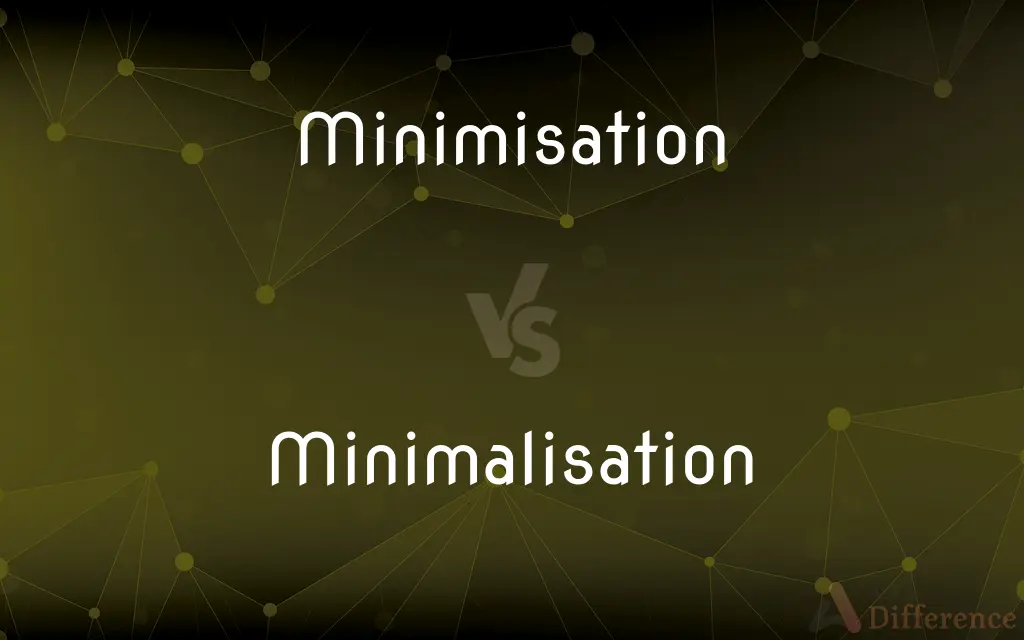Minimisation vs. Minimalisation — What's the Difference?
Edited by Tayyaba Rehman — By Urooj Arif — Updated on April 16, 2024
Minimisation focuses on reducing to the smallest possible amount or degree, whereas minimalisation emphasizes achieving a state of bare minimum.

Difference Between Minimisation and Minimalisation
Table of Contents
ADVERTISEMENT
Key Differences
Minimisation is primarily used to describe the process of making something as small or as least significant as possible. It is often used in mathematical, economic, and strategic contexts to signify reduction to the lowest achievable limit. Whereas, minimalisation, though less commonly used, refers to the act of reducing something to a minimal state, emphasizing simplicity and the reduction of elements to the bare essentials.
In computing, minimisation might refer to reducing the complexity of algorithms or minimizing data usage, striving for efficiency and optimization. On the other hand, minimalisation could be used in design contexts, where the goal is to achieve minimalism in aesthetics, stripping down to basic visual elements.
When discussing environmental strategies, minimisation is a term frequently applied to waste reduction techniques. It focuses on strategies that reduce waste generation from the outset. Conversely, minimalisation might be used in a similar context but with a stronger emphasis on achieving the least environmental impact, not just reducing waste amounts but also simplifying processes.
In legal contexts, minimisation might involve reducing legal exposure or liabilities to the minimum possible. Whereas minimalisation in this area isn't commonly used but might imply reducing the complexity of legal documents to what is minimally necessary.
In everyday language, minimisation is often about reducing the perceived importance of an issue, commonly referred to as "downplaying." Meanwhile, minimalisation, though rare, might be used to describe efforts to simplify or strip down a situation or problem to its essentials.
ADVERTISEMENT
Comparison Chart
Usage Contexts
Broad (computing, strategy, environmental)
More specific (often design, aesthetics)
Focus
Reducing to the smallest or least significant
Achieving minimal state, essential elements only
Common Fields
Computing, environmental strategies, legal
Design, visual arts
Implication
Efficiency, optimization
Simplicity, bare essentials
Example
Data minimisation in privacy policies
Minimalist design in art
Compare with Definitions
Minimisation
In mathematics, finding the smallest value of a function.
The algorithm aims for minimisation of the error rate.
Minimalisation
Rarely used in a technical context, more theoretical.
The thesis discusses the concept of minimalisation in modern architecture.
Minimisation
The act of reducing something to the least possible amount or degree.
The minimisation of waste is essential for sustainable living.
Minimalisation
Used in art and design, focusing on minimal elements.
Minimalisation in painting often involves using monochromatic colors.
Minimisation
In computing, reducing the complexity or size of code or data.
Data minimisation helps protect user privacy.
Minimalisation
Making something minimal or stripped to essentials.
His approach to lifestyle is guided by minimalisation.
Minimisation
Psychological term for downplaying issues.
He was accused of minimisation of his mistakes during the project.
Minimalisation
Conceptual approach in various artistic expressions.
Minimalisation in music involves using simple melodies and few instruments.
Minimisation
Legal strategy to decrease liability or risk.
Risk minimisation is crucial in corporate compliance.
Minimalisation
Not commonly used in everyday language.
Minimalisation of details can sometimes lead to misunderstandings.
Minimisation
Alternative spelling of minimization
Minimalisation
Alternative spelling of minimalization
Minimisation
Minimization.
Minimisation
The act of reducing something to the least possible amount or degree or position
Common Curiosities
Where is minimisation commonly used?
Minimisation is widely used in contexts like computing, environmental strategies, and legal settings.
What does minimalisation mean?
Minimalisation refers to making something minimal, focusing on the essential components and simplicity.
Is minimalisation a common term in legal documents?
No, minimalisation is not commonly used in legal contexts; minimisation is more prevalent.
What role does minimalisation play in design?
It strives for minimalism, using fewer elements to achieve a clean, uncluttered look.
What is minimisation?
Minimisation is the process of reducing something to the smallest possible amount or degree.
Can minimisation and minimalisation be used interchangeably?
Not typically, as they emphasize different aspects of reduction and are used in different contexts.
Which term is more prevalent in computing?
Minimisation is more prevalent, particularly in data reduction and algorithm optimization.
How is minimalisation different from minimisation?
While both involve reduction, minimalisation emphasizes simplicity and essentials, whereas minimisation focuses on reducing to the least amount.
How does minimisation impact environmental strategies?
It involves techniques that reduce waste and optimize resource use, contributing to sustainability.
How does minimalisation influence artistic expression?
It encourages focusing on the essential elements of art, often leading to innovative and modern creations.
How do minimisation and minimalisation relate to efficiency?
Minimisation is directly linked to increasing efficiency by reducing excess, while minimalisation focuses on aesthetic simplicity which may not necessarily increase efficiency.
Are there specific techniques associated with minimisation in waste management?
Yes, such as redesigning processes to reduce waste production and implementing recycling initiatives.
What psychological implications does minimisation have?
It can refer to the downplaying of problems or emotions, which might affect interpersonal communications.
Does minimalisation contribute to better understanding in communication?
It can lead to clarity through simplification but may also omit necessary details, risking misunderstandings.
Can minimisation be applied in personal finance management?
Yes, it involves reducing unnecessary expenses and optimizing budget allocation for financial stability.
Share Your Discovery

Previous Comparison
Client vs. Customer
Next Comparison
Ardent vs. FervorAuthor Spotlight
Written by
Urooj ArifUrooj is a skilled content writer at Ask Difference, known for her exceptional ability to simplify complex topics into engaging and informative content. With a passion for research and a flair for clear, concise writing, she consistently delivers articles that resonate with our diverse audience.
Edited by
Tayyaba RehmanTayyaba Rehman is a distinguished writer, currently serving as a primary contributor to askdifference.com. As a researcher in semantics and etymology, Tayyaba's passion for the complexity of languages and their distinctions has found a perfect home on the platform. Tayyaba delves into the intricacies of language, distinguishing between commonly confused words and phrases, thereby providing clarity for readers worldwide.
















































